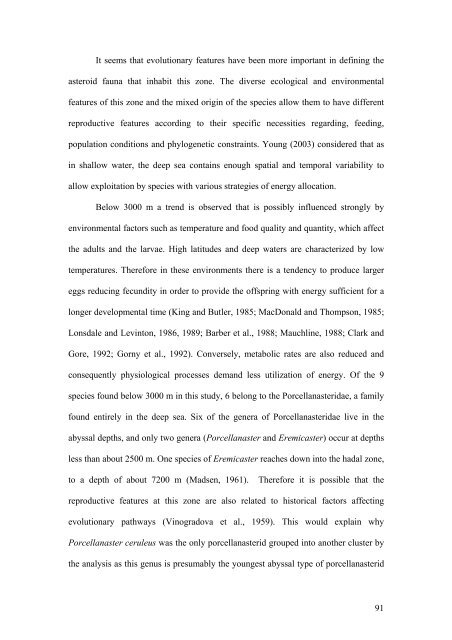Download (3398Kb) - ePrints Soton - University of Southampton
Download (3398Kb) - ePrints Soton - University of Southampton
Download (3398Kb) - ePrints Soton - University of Southampton
Create successful ePaper yourself
Turn your PDF publications into a flip-book with our unique Google optimized e-Paper software.
It seems that evolutionary features have been more important in defining the<br />
asteroid fauna that inhabit this zone. The diverse ecological and environmental<br />
features <strong>of</strong> this zone and the mixed origin <strong>of</strong> the species allow them to have different<br />
reproductive features according to their specific necessities regarding, feeding,<br />
population conditions and phylogenetic constraints. Young (2003) considered that as<br />
in shallow water, the deep sea contains enough spatial and temporal variability to<br />
allow exploitation by species with various strategies <strong>of</strong> energy allocation.<br />
Below 3000 m a trend is observed that is possibly influenced strongly by<br />
environmental factors such as temperature and food quality and quantity, which affect<br />
the adults and the larvae. High latitudes and deep waters are characterized by low<br />
temperatures. Therefore in these environments there is a tendency to produce larger<br />
eggs reducing fecundity in order to provide the <strong>of</strong>fspring with energy sufficient for a<br />
longer developmental time (King and Butler, 1985; MacDonald and Thompson, 1985;<br />
Lonsdale and Levinton, 1986, 1989; Barber et al., 1988; Mauchline, 1988; Clark and<br />
Gore, 1992; Gorny et al., 1992). Conversely, metabolic rates are also reduced and<br />
consequently physiological processes demand less utilization <strong>of</strong> energy. Of the 9<br />
species found below 3000 m in this study, 6 belong to the Porcellanasteridae, a family<br />
found entirely in the deep sea. Six <strong>of</strong> the genera <strong>of</strong> Porcellanasteridae live in the<br />
abyssal depths, and only two genera (Porcellanaster and Eremicaster) occur at depths<br />
less than about 2500 m. One species <strong>of</strong> Eremicaster reaches down into the hadal zone,<br />
to a depth <strong>of</strong> about 7200 m (Madsen, 1961). Therefore it is possible that the<br />
reproductive features at this zone are also related to historical factors affecting<br />
evolutionary pathways (Vinogradova et al., 1959). This would explain why<br />
Porcellanaster ceruleus was the only porcellanasterid grouped into another cluster by<br />
the analysis as this genus is presumably the youngest abyssal type <strong>of</strong> porcellanasterid<br />
91
















